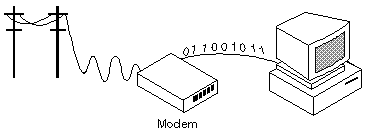|
MODEM
A
"modulator/demodulator" - a device that enables one
computer to communicate with another using ordinary telephone
lines.
More Detailed Definition:

Short for modulator-demodulator.
A modem is a device or program that enables a computer to transmit
data over, for example, telephone or cable lines. Computer
information is stored digitally, whereas information transmitted
over telephone lines is transmitted in the form of analog waves. A
modem converts between these two forms.
Fortunately, there is one standard interface for connecting
external modems to computers called RS-232. Consequently, any
external modem can be attached to any computer that has an RS-232
port, which almost all personal computers have. There are also
modems that come as an expansion board that you can insert into a
vacant expansion slot. These are sometimes called onboard or
internal modems.
While the modem interfaces are standardized, a number of different
protocols for formatting data to be transmitted over telephone
lines exist. Some, like CCITT V.34, are official standards, while
others have been developed by private companies. Most modems have
built-in support for the more common protocols -- at slow data
transmission speeds at least, most modems can communicate with
each other. At high transmission speeds, however, the protocols
are less standardized.
Aside from the transmission protocols that they support, the
following characteristics distinguish one modem from another:
- bps : How fast the modem can transmit and receive data. At slow
rates, modems are measured in terms of baud rates. The slowest
rate is 300 baud (about 25 cps). At higher speeds, modems are
measured in terms of bits per second (bps). The fastest modems run
at 57,600 bps, although they can achieve even higher data transfer
rates by compressing the data. Obviously, the faster the
transmission rate, the faster you can send and receive data. Note,
however, that you cannot receive data any faster than it is being
sent. If, for example, the device sending data to your computer is
sending it at 2,400 bps, you must receive it at 2,400 bps. It does
not always pay, therefore, to have a very fast modem. In addition,
some telephone lines are unable to transmit data reliably at very
high rates.
- voice/data: Many modems support a switch to change between voice
and data modes. In data mode, the modem acts like a regular modem.
In voice mode, the modem acts like a regular telephone. Modems
that support a voice/data switch have a built-in loudspeaker and
microphone for voice communication.
auto-answer : An auto-answer modem enables your computer to
receive calls in your absence. This is only necessary if you are
offering some type of computer service that people can call in to
use.
- data compression : Some modems perform data compression, which
enables them to send data at faster rates. However, the modem at
the receiving end must be able to decompress the data using the
same compression technique.
- flash memory : Some modems come with flash memory rather than
conventional ROM, which means that the communications protocols
can be easily updated if necessary.
- fax capability: Most modern
modems are fax modems, which means that they can send and
receive faxes.
To get the most out of a modem, you should have a communications
software package, a program that simplifies the task of
transferring data.
|
